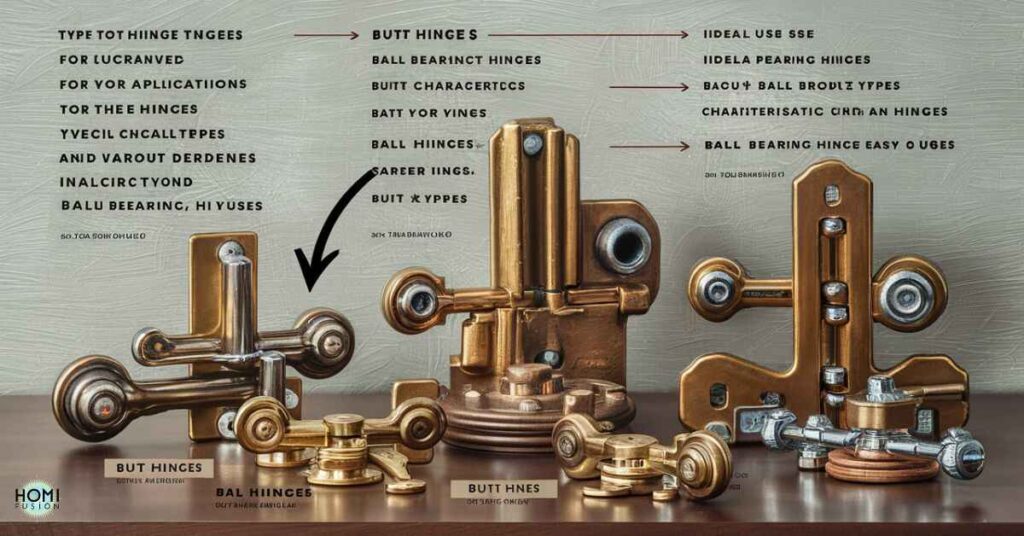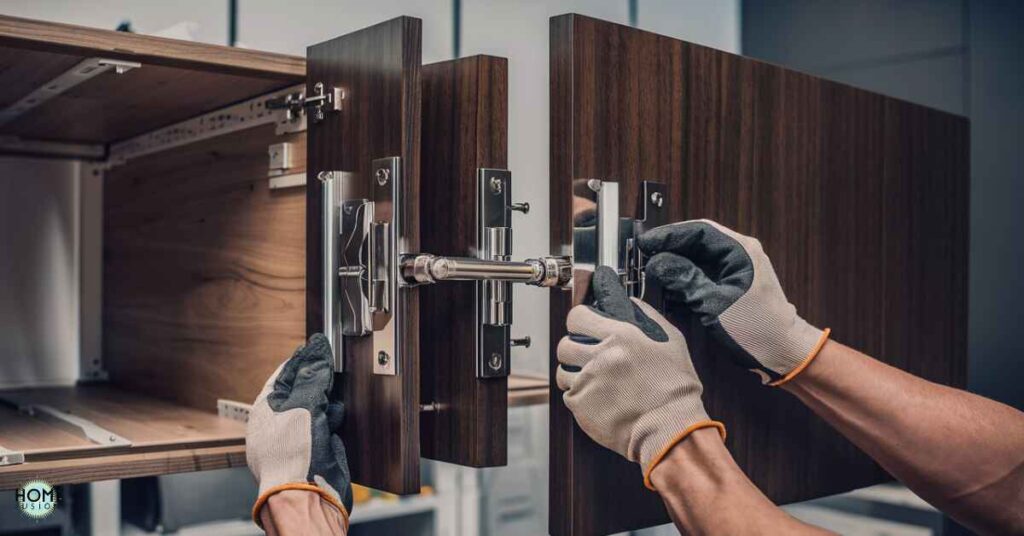You are not the only one. It can break or make the project how one chooses the right number and type of hinges on the cabinet doors. Standing in the hardware store, have you ever found yourself staring blankly at an overwhelming array of cabinet hinges?
Let me share a personal story that illustrates the importance of this seemingly small detail. A few years ago, I decided to give my kitchen a much-needed facelift by installing brand new cabinets.
I meticulously measured, cut and assembled each piece, only to realize (too late) that I had severely underestimated the number of hinges needed for those heavy, solid oak doors. You can probably guess what happened next – sagging, sticking, and all-around misalignment that made me want to tear my hair out.
The lesson? Don’t make the same mistake I did. Determining the proper number of hinges per cabinet door requires careful consideration of several key factors:
- Door weight
- Door size (height and width)
- Door material and construction
- Type of hinge being used
By taking the time to understand each of these elements, you’ll ensure your cabinet doors operate smoothly for years to come. So let’s dive in and explore the ultimate guide to selecting the right number of hinges!
Door Weight Considerations
When it comes to cabinet hinges, weight is arguably the most crucial factor. The heavier the door, the more support (and heavy-duty hinges) you’ll need to prevent sagging and premature wear.
Think of it like a table – would you want to place a heavy granite tabletop on just two spindly legs? Of course not! The more “legs” (aka hinges) you have distributing that substantial weight, the better. The same principle applies to cabinet doors.
As a general guideline:
- For doors under 10 lbs, two hinges are typically sufficient
- 10-20 lb doors usually require three hinges
- Anything over 20 lbs demands a minimum of four heavy-duty hinges
But weight isn’t just about the final number on the scale. The door’s material plays a big role too. A solid hardwood door, like oak or maple, is going to be significantly heavier than a hollow core or medium-density fiberboard (MDF) door of the same dimensions.
| Door Material | Typical Weight Range |
| Solid Hardwood | 15-30 lbs |
| MDF | 10-20 lbs |
| Hollow Core | 5-15 lbs |
So if you’re working with a solid oak door that tips the scales at 25 lbs, you’ll definitely want to opt for those heavy-duty, high-weight capacity hinges made specifically for substantial doors. Most residential hinges max out at around 30-40 lbs per hinge, so going over that range risks serious sagging or failure down the road.
On the other hand, if you have relatively lightweight MDF or hollow core doors, standard hinges should provide sufficient support in most cases. Just be sure not to overload them.
“An ounce of prevention through proper hinge selection is worth a pound of cure trying to fix a sagging door.” – Anonymous Cabinet Maker
Door Height & Width Factors

While door weight is paramount, the physical size of your cabinet doors also dictates how many hinges you’ll need. As the old adage goes – the bigger they are, the more they require breathing room in the form of additional hinge support.
In general, you’ll want one hinge for every 30 inches of door height. So a standard 60″ tall cabinet would use two hinges, while anything over 90″ calls for a minimum of three evenly spaced out.
Here’s a quick reference chart to visualize it:
| Door Height | Recommended # Hinges |
| Under 40″ | 2 |
| 40″ – 60″ | 2-3 |
| 60″ – 90″ | 3 |
| Over 90″ | 3-4+ |
But height isn’t the whole story when it comes to size – the width of your doors also plays a crucial role. Wider cabinet doors have a larger swing radius which puts more torque and stress on the hinges. Because of this added strain, you may need to increase the overall number of hinges used.
As a rule of thumb, doors over 24” wide should consider using an extra hinge. And for those jumbo slabs over 36” across, I’d highly recommend a fourth hinge to handle that extreme swing weight.
While hitting that “Goldilocks” medium range of 40-60” tall by 24-36” wide requires less stringent hinge rules, it’s always better to over-support than under-support your doors. Trust me, avoiding inevitable sagging and poor operation is worth the extra hinges!
Door Material & Construction

We’ve covered how the sheer weight and size of your cabinet doors dictate basic hinge requirements. But the specific material and construction methods used can also necessitate adjustments to your hinge plan.
As we discussed earlier, ultra-dense hardwood doors like oak or maple demand hefty heavy-duty hinges capable of bearing that substantial heft. But certain alternative materials can provide comparable sturdiness without being literal lead weights.
For example, aluminum or composite wood doors are frequently just as solid yet lighter than real hardwood. These can sometimes get away with slightly fewer hinges while still maintaining excellent structural integrity.
On the flip side, you have cabinet doors constructed with lighter wood frames around a hollow core interior. While nowhere near as dense as solid oak, these doors still carry a fair amount of weight that requires properly robust hinges and quantities.
Another factor is whether the door surface contains any raised or recessed panel sections versus being a simple flat slab. Those additional design elements usually translate to extra weight that necessitates more hinges for support.
You’ll also want to consider door thickness. Most residential cabinets use 3/4″ thick doors, which fit standard-sized hinges just fine. But any thicker doors (like 1″ boards used for frameless European-style cabinets) require special wider hinges to accommodate that increased girth.
The key takeaway? Don’t blindly choose hinges based only on weight or height/width. Carefully evaluate the specific material AND construction of your doors, making adjustments accordingly.
Hinge Types & Choices
With so many different styles and mechanisms of cabinet hinges out there, how do you decide which type to use? Let’s take a look at some of the major players and their unique characteristics:

Butt Hinges
These standard, basic hinges have been used for cabinets since basically the dawn of woodworking. Butt hinges consist of two flat plates joined by a cylindrical barrel. They are durable workhorses well-suited for medium-weight doors that do not require fancy open/close operations.
Ball-Bearing Hinges
As the name implies, these hinges incorporate small ball-bearings between the barrel and plate interfaces. This allows for smoother, lower-friction opening/closing that’s ideal for heavier cabinet doors. The ball-bearings effortlessly handle that extra weight through their entire swing radius.
Wide Throw & Semi-Concealed Hinges
Wide throw hinges have an extended barrel that provides a wider maximum degree of opening. They are useful for situations where you need cabinet doors to open fully and stay put against the cabinets. Semi-concealed versions have one plate inset so only a narrower edge remains visible when closed.
Concealed/Euro-Style Hinges
These hinges mount the door and cabinet plates on the interior, leaving no external hardware visible for a clean, streamlined look. Concealed hinges are very popular for modern frameless “Euro” style cabinets. However, they are more complex to install and adjust.
Surface-Mounted Decorative Hinges
While functionally similar to basic butt hinges, these decorative strap and surface-mounted styles offer a wide range of aesthetic finishes and designs. From traditional iron looks to sleek contemporary styles, decorative hinges let you add custom style to your cabinets.
With such a vast selection, how do you choose? For most standard cabinet doors, I’d recommend:
- Ball-bearing hinges for optimum weight support and smooth operation
- Wide throw add-ons if you need doors fully extended against cabinets
- Concealed/Euro hinges only if you have the right frameless cabinet construction
But don’t forget the decorative aspect too! Even if you opt for a basic hinge function, surface-mounted hinges offer versatility. They allow you to enhance your cabinet style with a wide range of finishes, shapes, and designs.
Read this blog: How Long Do Kitchen Cabinets Last
Proper Hinge Installation

Your efforts in selecting hinges can be wasted if the installation isn’t done properly. Proper installation is crucial for ensuring the functionality and durability of your cabinet doors. Hinge misalignment, improper spacing, and poor attachment can quickly lead to binding, sticking, and sagging no matter how heavyweight the hardware.
The good news? Getting hinge installation right isn’t overly complicated if you follow some simple best practices:
Measure Twice, Install Once
The old carpenter’s mantra holds true for hinges too. Carefully measuring and marking the hinge locations on both the door and cabinet frame is crucial. Most hinges should be inset about 1/4″ from the door edge.
For reference:
- Top hinge: 2-4 inches down from top of door
- Bottom hinge: 6-10 inches up from bottom of door
- Any additional hinges: evenly spaced between top and bottom
Mind the Gap
Pay close attention to the gap spacing between the door and cabinet when the hinges are in their closed position. 1/8″ is the typical clearance you’ll want to shoot for on all sides. Hinge spacers or shims can help achieve this.
Install Hinges Gradually
When first mounting the hinges, only tighten the screws part way and continually test/adjust the hang of the door. You want to install all hinges before fully tightening any one completely.
Consider a Hinge Jig
For tricky hinge installations like those pesky concealed Euro hinges, a sturdy hinge jig or door lift can be a worthwhile investment. These handy tools ensure perfect, repeatable alignment every time.
Fine Tune as Needed
Once all hinges are installed, double check operation and make any final adjustments for door height, clearance gaps, and tension. Many higher-end hinges have adjustment screws just for this purpose.
Of course, even following all instructions to a tee, cabinet door hinge installation can still throw curveballs at you sometimes. Maybe the screws start stripping out, or the frame isn’t perfectly square, or the door itself starts sagging after hang. Don’t get discouraged!
The key is taking your time, double checking alignment at every step, and being patient with any needed adjustments. It may not be glamorous work, but getting those hinges properly dialed in lays the foundation for smooth cabinet function for decades to come.
Also read: Can You Replace Countertops Without Replacing Cabinets?
Additional Tips & Considerations
To wrap up our comprehensive guide, here are some final pro tips and extra considerations to mull over when determining hinge quantities:
Using Hinge Spacers or Lips
Depending on the type of hinge and cabinet construction, you may need to use spacers or plastic hinge lips. These inexpensive accessories provide a couple key benefits:
- They create perfect even spacing between the door and cabinet frame
- Lips can protect cabinet faces from dings when doors are opened
- Spacers can shift the door position out slightly for clearance
Adjusting Tension & Alignments
Over time, even properly installed cabinet door hinges can loosen up or fall out of alignment through repeated use. Many modern hinges offer adjustment screws to:
- Increase/reduce door tension or travel distance
- Tweak the height of the door vertically
- Realign the door angle in/out from the cabinet face
Take advantage of these tuning options to keep doors operating smoothly.
Reusing Existing Hinges
When replacing old cabinets, you might consider transferring existing hinges to the new doors. However, this depends on the condition and compatibility of the hinges with the new doors. In some cases, definitely!
However, hinges showing any wear or looseness in the old installation should be replaced with fresh hardware. And adjusting for any weight/size differences in the new doors is critical too.
Troubleshooting Common Issues
What if you’ve followed all the installation tips yet still encounter problems? Here are some quick troubleshooting suggestions:
- Sagging doors = add another hinge, use heavy-duty hinges
- Binding/sticking = adjust hinge alignments, check for frame obstructions
- Creaking/Squeaking = apply lubricant like wax or silicone spray
- Uneven gaps = readjust using the hinge screws, shim if needed
Don’t just live with frustrating hinge issues. Proper adjustments or even complete hinge replacements can usually solve the problem.
Frequently asked questions
How do you calculate the number of hinges?
Calculate hinges based on door weight (2-4 for heavy doors), height (1 per 30″), width (consider extra for wide doors), and material strength.
What is the correct spacing for cabinet door hinges?
The correct spacing for cabinet door hinges is typically 1/4″ inset from the door edge. Hinge locations vary, with top hinges around 2-4 inches down and bottom hinges 6-10 inches up from door ends.
How many hinges for a 7kg door?
For a 7kg door, two hinges are typically sufficient for adequate support and smooth operation.
What is the distance between door hinges?
The distance between door hinges varies. Generally, the top hinge is placed 2-4 inches down from the top of the door, while the bottom hinge is situated 6-10 inches up from the bottom.
How to determine cabinet hinge size?
Determine cabinet hinge size based on door weight, height, and width. Heavy doors need larger hinges, while taller and wider doors may require additional or larger hinges.
Conclusion
There you have it – the ultimate guide to selecting the proper number of hinges for your cabinet doors! Choosing the right hinges may seem small, but it sets the foundation for flawless cabinet operation and long-lasting aesthetics. This decision greatly impacts the functionality and appearance of your cabinets in the long run.
To quickly summarize the key considerations:
- Door Weight: Heavier doors need more heavy-duty hinges (3+ for over 20 lbs)
- Door Size: Use 1 hinge per 30″ of height, plus extras for wide doors
- Materials: Hardwoods usually require more heavy-duty hardware
- Design Elements: Raised panels and thicker doors dictate hinge specifications
But don’t just take my word for it. Here’s what some experienced cabinet makers have to say about the importance of hinge selection:
“Picking the right hinges is just as critical as the door material itself. It’s what allows that weight to actually move!”
(JohnMaxwell, Woodworker’s Journal)
“I’ve seen way too many DIY cabinet jobs ruined by using flimsy hinges that can’t handle the long-term abuse. It’s never worth skimping on hinges.”
(Ana White, Ana-White.com)
The modest cabinet door hinge is the unsung hero that allows your cabinets to perform day in and day out for decades. So do your future self a favor – invest the time into choosing and installing hinges properly. Your cabinets will thank you!







